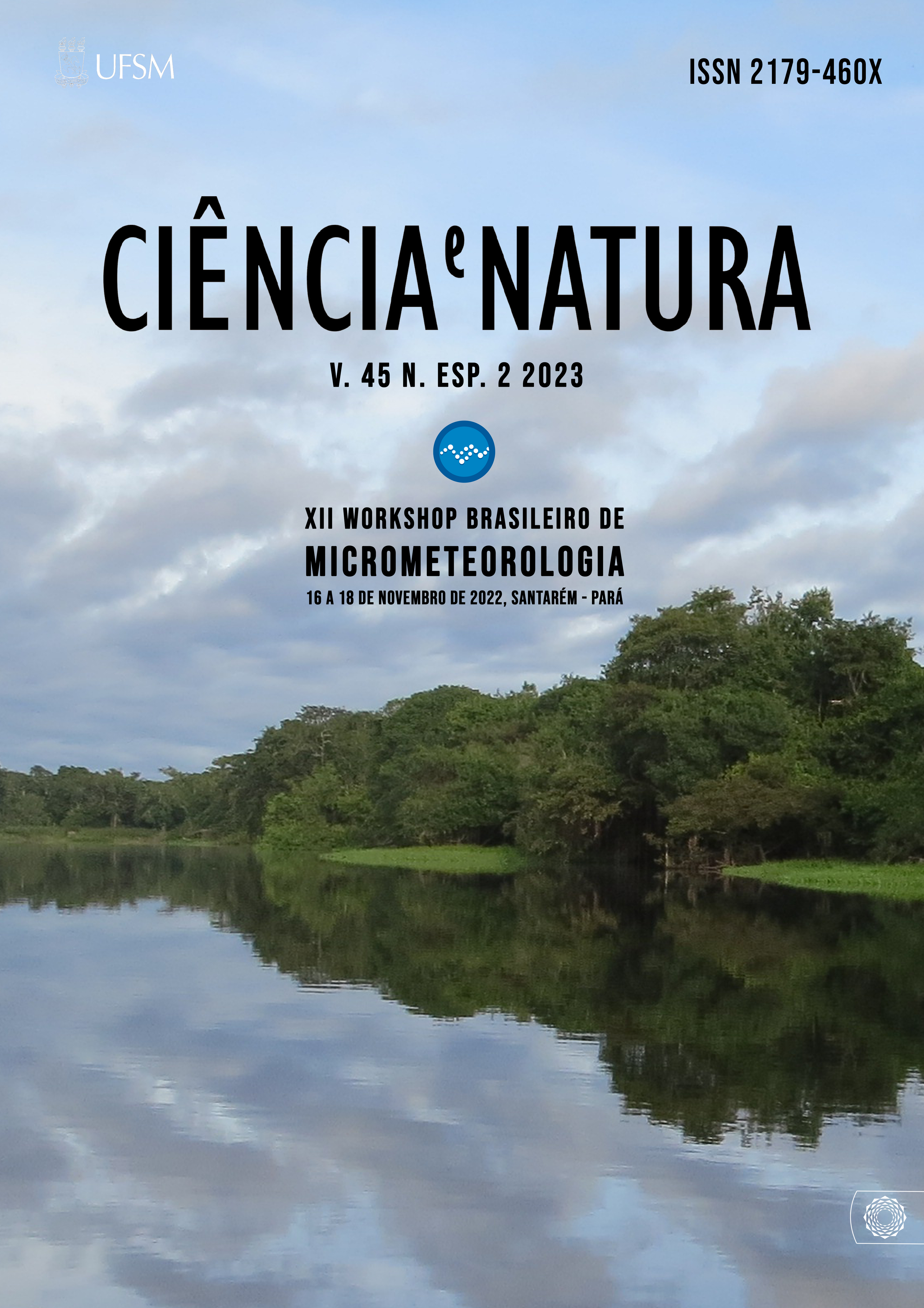Teoria estatística da turbulência aplicada ao modelo global BAM-INPE
DOI:
https://doi.org/10.5902/2179460X78815Palavras-chave:
Turbulência atmosférica, Parametrização pela teoria de Taylor, Modelo BAMResumo
A teoria estatística da turbulência de G. I. Taylor é empregada como referência para parametrização da turbulência no modelo global de circulação atmosférica BAM (Brazilian global Atmospheric Model). O modelo BAM é utilizado operacionalmente para gerar dados de previsão numérica do tempo pelo INPE. As execuções de simulação do modelo BAM com parametrização baseada na teoria de Taylor é comparada com os resultados obtidos com a parametrização de Holtslag-Boville (1993). Um bom desempenho com a nova parametrização é observado a partir dos resultados.
Downloads
Referências
CAMPOS VELHO, H. F.: Modelagem Matemática em Turbulência Atmosférica. Sociedade Brasileira de Matemática Aplicada e Computacional (SBMAC): Notas em Matemática Aplicada - No. 48, 2010. Disponível em: https://proceedings.science/series/23/proceedings_non_indexed/53
DEGRAZIA, G. A.; ANFOSSI, D.; CARVALHO, J. C.; MANGIA, C.; TIRABASSI, T; CAMPOS VELHO, H. F.; Turbulence parameterization for PBL dispersion models in all stability conditions. Atmospheric Environment, v. 34, p. 3575-3583, 2000. DOI: https://doi.org/10.1016/S1352-2310(00)00116-3
DUEBEN, P. D.; BAUER, P. Challenges and design choices for global weather and climate models based on machine learning. Geoscientific Model Development, p. 3999-4009, 2018. DOI: https://doi.org/10.5194/gmd-11-3999-2018
FIGUEROA, S. N.; BONATTI, J. P.; KUBOTA, P. Y.; GRELL, G. A.; MORRISON, H.; BARROS, S. R.; FERNANDEZ, J. P.; RAMIREZ, E.; SIQUEIRA, L.; LUZIA, G.; et al.: The Brazilian global atmospheric model (BAM): performance for tropical rainfall forecasting and sensitivity to convective scheme and horizontal resolution. Weather and Forecasting, v. 31, 1547–1572, 2016. DOI: https://doi.org/10.1175/WAF-D-16-0062.1
HERSBACH, H; BELL, B; BERRISFORD, P, et al. The ERA5 global reanalysis. Q J R Meteorol Soc. 2020; 146: 1999– 2049. https://doi.org/10.1002/qj.3803 DOI: https://doi.org/10.1002/qj.3803
HOLTSLAG, A.; BOVILLE, B. A.; Local versus nonlocal boundary-layer diffusion in a global climate model. Journal of Climate, v. 6, n. 10, 1825–1842, 1993. DOI: https://doi.org/10.1175/1520-0442(1993)006<1825:LVNBLD>2.0.CO;2
IACONO, M. J.; DELAMARE, J. S.; MLAWER, E. J.; SHEPHARD, M. W.; CLOUGH, S. A.; COLLINS, W. D.: Radiative forcing by long-lived greenhouse gases: Calculations with the AER radiative transfer models. Journal of Geophysical Research Atmospheres, v. 113, n. 13, 2008. DOI: https://doi.org/10.1029/2008JD009944
KUBOTA, P.Y.: Variabilidade de Energia Armazenada na Superfície e seu Impacto na Definição do Padrão de Precipitação na América do Sul. Tese de doutorado, INPE, 2012.
MELLOR, G. L.; YAMADA, T;: Development of a turbulence closure model for geophysical fluid problems. Reviews of Geophysical Physics and Space Physics, v. 20, 851-875,1982. DOI: https://doi.org/10.1029/RG020i004p00851
MORRISON, H.; THOMPSON, G.; TATARSKII, V.: Impact of cloud microphysics on the development of trailing stratiform precipitation in a simulated squall line: Comparison of one- and two-moment schemes. Monthly Weather Review, v. 137, n. 3, 991–1007 (2009). DOI: https://doi.org/10.1175/2008MWR2556.1
STULL, R. B.: An Introduction to Boundary Layer Meteorology. Springer Science & Business Media, 1988. DOI: https://doi.org/10.1007/978-94-009-3027-8
TAYLOR, G. I.: Diffusion by continuous movements. Proceedings of London Mathematical Society, v. 20, 196–211, 1921. DOI: https://doi.org/10.1112/plms/s2-20.1.196
Downloads
Publicado
Como Citar
Edição
Seção
Licença
Copyright (c) 2023 Ciência e Natura

Este trabalho está licenciado sob uma licença Creative Commons Attribution-NonCommercial-ShareAlike 4.0 International License.
Para acessar a DECLARAÇÃO DE ORIGINALIDADE E EXCLUSIVIDADE E CESSÃO DE DIREITOS AUTORAIS clique aqui.
Diretrizes Éticas para Publicação de Revistas
A revista Ciência e Natura está empenhada em garantir a ética na publicação e na qualidade dos artigos.
A conformidade com padrões de comportamento ético é, portanto, esperada de todas as partes envolvidas: Autores, Editores e Revisores.
Em particular,
Autores: Os Autores devem apresentar uma discussão objetiva sobre a importância do trabalho de pesquisa, bem como detalhes e referências suficientes para permitir que outros reproduzam as experiências. Declarações fraudulentas ou intencionalmente incorretas constituem comportamento antiético e são inaceitáveis. Artigos de Revisão também devem ser objetivos, abrangentes e relatos precisos do estado da arte. Os Autores devem assegurar que seu trabalho é uma obra totalmente original, e se o trabalho e / ou palavras de outros têm sido utilizadas, isso tem sido devidamente reconhecido. O plágio em todas as suas formas constitui um comportamento publicitário não ético e é inaceitável. Submeter o mesmo manuscrito a mais de um jornal simultaneamente constitui um comportamento publicitário não ético e é inaceitável. Os Autores não devem submeter artigos que descrevam essencialmente a mesma pesquisa a mais de uma revista. O Autor correspondente deve garantir que haja um consenso total de todos os Co-autores na aprovação da versão final do artigo e sua submissão para publicação.
Editores: Os Editores devem avaliar manuscritos exclusivamente com base no seu mérito acadêmico. Um Editor não deve usar informações não publicadas na própria pesquisa do Editor sem o consentimento expresso por escrito do Autor. Os Editores devem tomar medidas de resposta razoável quando tiverem sido apresentadas queixas éticas relativas a um manuscrito submetido ou publicado.
Revisores: Todos os manuscritos recebidos para revisão devem ser tratados como documentos confidenciais. As informações ou ideias privilegiadas obtidas através da análise por pares devem ser mantidas confidenciais e não utilizadas para vantagens pessoais. As revisões devem ser conduzidas objetivamente e as observações devem ser formuladas claramente com argumentos de apoio, de modo que os Autores possam usá-los para melhorar o artigo. Qualquer Revisor selecionado que se sinta desqualificado para rever a pesquisa relatada em um manuscrito ou sabe que sua rápida revisão será impossível deve notificar o Editor e desculpar-se do processo de revisão. Os Revisores não devem considerar manuscritos nos quais tenham conflitos de interesse resultantes de relacionamentos ou conexões competitivas, colaborativas ou outras conexões com qualquer dos autores, empresas ou instituições conectadas aos documentos.






